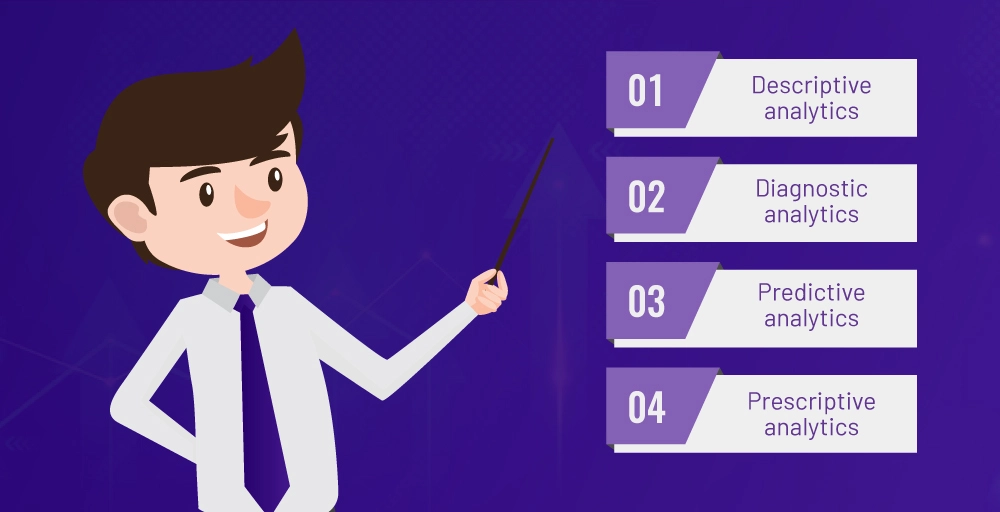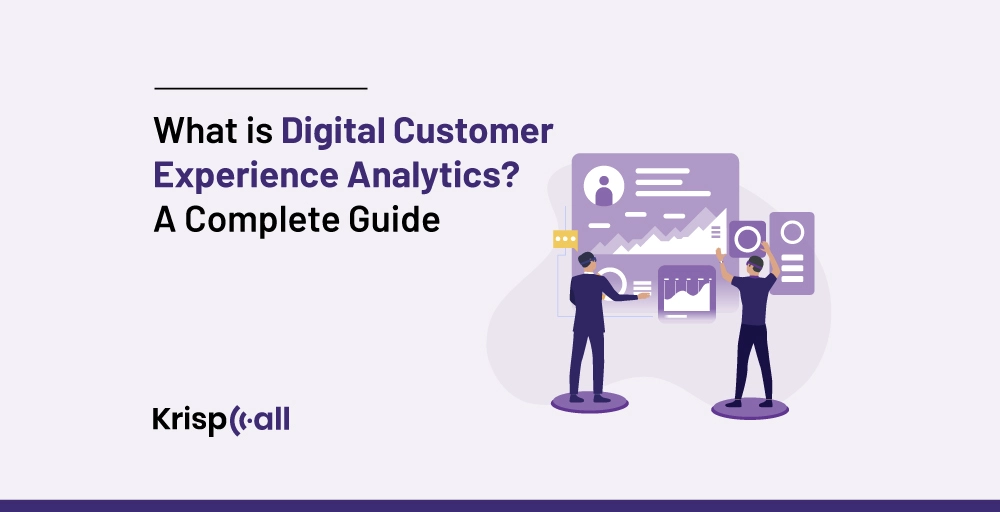Customers today use multiple platforms which creates a challenge for businesses to manage customer interactions through various digital channels. These problems lead to missed opportunities and difficulty in understanding customer behavior, needs, and preferences that directly influences buying decisions.
Here is where Digital customer experience analytics walks in, it is a powerful tool for understanding how customers interact with a business digitally which helps companies to increase customer engagement and loyalty.
According to marq, 73% of customers say that a company’s customer experience affects their decision to buy any product or service. 86% of buyers are ready to pay more for a great experience, and 73% of dissatisfied customers will move to another competitor if they experience one or more negative experiences from their current service provider company.
Read this blog till the end to learn more about digital customer experience analytics, including its benefits, types, use cases, and best practices of digital customer experience analytics.
Let’s get started 🚀
🔑KEY HIGHLIGHTS
- Digital customer experience analytics is the study of customer data, experiences, and viewpoints for understanding and improving customer needs and satisfaction.
- The metrics to measure customer experiences are CSAT, CES, NPS, CLV, Retention, and Churn rate.
- The 4 types of analytics are Descriptive, Diagnostic, Predictive, and Prescriptive.
- Digital customer experience analytics helps understand customer behavior, design personalized experiences, and evolve with predictive analytics.
- For using digital customer analytics to its fullest, focus on providing personalized experiences, omnichannel strategies, employing AI, and updating the platform consistently.
- To track digital customer experience, create journey maps, conduct surveys, and use customer journey analytics tools.
What is digital customer experience analytics?
Digital customer experience analytics is the study of customer data, viewpoints, and experiences with the business’s products and services to understand customer needs. It helps your business increase customer loyalty and engagement by improving the customer journey. This allows your company to act on issues that affect customer satisfaction by any chance.

For example, if a company conducts a survey and its Net Promoter Score (NPS) is below 0, it indicates that there are more detractors than promoters among the customers. Now, to increase the score and improve customer experience, businesses should focus on understanding why customers gave the scores they did. By addressing the reasons behind the scores, companies can provide better, customer-focused services. Doing this will directly boost brand’s reputation, too.
Why is digital customer experience analytics important?
Collecting as much data from customer interactions is vital because it helps to gain information for identifying gaps and opportunities in customer service to ensure a better customer experience in digital platforms.
Some of the benefits of digital customer experience analytics are:
- Understanding customer behavior: Digital customer experience analytics provides insights into how customers interact with your digital platforms. This understanding is essential for improving the needed field and helps maintain customer retention management.
- Improved customer satisfaction and experience: With customer experience analytics, you can fulfill customer needs and let them enhance their experience. 84% of consumers say that experience is more important than products.
- Measuring performance and ROI: Businesses can track key performance indicators(KPIs) like net promoter scores, customer satisfaction scores, and conversion rates. These KPIs provide insights on customer satisfaction, willingness to purchase from you, and likelihood of recommending your products to others. With this information, businesses can make decisions based on customer requirements and improve return on investment (ROI).
- Optimizing customer journeys: With detailed CX analytics, companies can manage customer journeys by analyzing the key touchpoints of customers’ engagement, which eventually improves overall customer journey optimization.
What are the metrics to measure customer experience?
The customer experience(CX) is the total summary of the customer’s interaction with your company, which is an essential factor in gaining insight into how the customer feels about the company. Customer experience measurement metrics can help you get a brief understanding of it.
Some of the metrics to measure customer experience are:
- Customer Satisfaction Score(CSAT): The customer satisfaction score is a business standard for measuring user satisfaction with a company’s services and products. It is measured by a survey that includes questions related to how satisfied customers were with the service or product on a scale from 1 to 5. 5 is considered very satisfied, and 1 is very unsatisfied.
- Customer Effort Score(CES): 94% of customers say they will likely return to a brand if they have an effortless experience. The customer effort score is the metric for measuring the effort a customer has to put in while interacting with your company, from initial interaction to finally deciding to purchase from you. It asks customers questions like, “How easy was that to complete [ action here ]?” after they complete an important action like making a purchase, using any service, or talking to customer support.
- Net Promoter Score(NPS): Net Promoter Score is a customer loyalty metric in which customers are asked, ” How likely are they to recommend a company’s product and service to their friends and colleagues on a scale of 0 to 10?” This can be done in multiple ways. One way is to ask questions just after the purchase or use of the service, and another is to survey between the three-month gap and sometimes in a year. According to lumoa an average NPS increase of 7% correlates with a 1% growth in revenue.
- Customer Lifetime Value (CLV): Customer lifetime value is a customer experience measurement metric that indicates the total revenue that a business can expect to generate from a single customer throughout the entire relationship. It is calculated by collecting customer average purchase value, purchase frequency, customer value, and average lifespan within a year and then using the formula, “Customer lifetime value (CLV)= Customer Value * Average Customer Lifespan.”
- Retention rate and churn rate: Customer churn rate measures the number of customers who stop buying or subscribing to a company’s products. In contrast, customer retention rate is the business’s ability to hold customers for a period of time. SaaS businesses’ monthly churn is calculated by dividing the customers who cancel by the number of beginning customers for a month. Retention is tracked through cohort analysis of customer groups that made repeat purchases in a limited time.
What are the types of analytics used in digital customer experience analytics?
Analytics helps to understand past records, make future plans, and determine necessary actions for a company’s growth. Four types of analytics are primarily used in digital customer experience analytics.

Here are the 4 types of analytics used in digital customer experience analytics:
- Descriptive analytics: Descriptive analytics is used to understand performance at an aggregate level and answer the question, “ What happened?” These analytics results are presented through reports, bar charts, dashboards, and other visualizations that can be easily understood. Businesses use statistical analysis techniques to transform raw data into a form where patterns and anomalies can be identified.
- Diagnostic analytics: While descriptive analytics focuses on “what happened,” diagnostic analytics focuses on the important question, “Why did it occur?” It also uses historical data to answer questions, but this is the most overlooked analytics. Customers are willing to go from “what happened” to “ what will happen” without even giving value to the question, “Why did it happen?”
- Predictive analytics: As its name suggests, Predictive analytics is a form of advanced analytics that uses machine learning to predict what is likely to happen based on historical data. It helps predict the possible maintenance issues and credit risk, predicting and helping to avoid customer churn.
- Prescriptive analytics: Prescriptive analytics is the most modern analytics that guides you to take specific action. It effectively merges all descriptive, diagnostic, and predictive analytics for decision-making. It helps address automatic price adjustments based on customer demand and other factors.
What are the use cases of digital customer experience analytics?
Digital customer experience analytics help increase customer engagement and make customer-engaged services.
Some other use cases of digital customer experience analytics are:
- Understanding customer behavior: Customer experience analytics can monitor customers’ interactions with your business through different touchpoints. This gives you insights into what works and what can be improved to optimize the overall customer support system and services.
- Designing a customer satisfaction-oriented experience: Data-based customer experience analytics allows you to build a customer-focused design by understanding what customers value and want. Addressing pain points lets you improve customer satisfaction.
- Creating a loyal customer base: Developing personalized services for customers helps maintain a strong relationship with them. This increases customer loyalty because every customer expects to get customized services.
- Evolve with predictive analytics: With predictive analytics, you can pre-determine future decisions based on historical datas and analytics. This approach leads your company to evolve and prepare strategies for meeting customer needs and preferences.
Best practices for improving digital customer experiences
The main components for improving digital customer experience strategy include factors like customer feedback, analytics of customer journey, and customer satisfaction rates.
Some of the best practices for improving digital customer experiences are:
- Go beyond the basic analytics: You should not be relying solely on the analytics of datas; instead, go for getting insight with the real-time experiences talking with customers. Have interviews with precious customers to determine your product’s pros and cons. Remember, only the quantitative data alone is not enough.
- Provide a personalized experience based on customer data: Use your customer data to provide personalized experiences. To do this, you can centralize data in a unified platform to train the algorithms. Another way is to deliver a consistent experience based on customer preferences, and you need to upgrade the generative AI for more personalized recommendations.
- Improve customer experience using omnichannel strategies: Using omnichannel for improving customer is considered an essential digital customer experience strategy You need to ensure that you provide consistent messages and efforts on all your social media channels. Customers can discover your product from any channel. For example, they can learn about your company through your website, content, social media app, or word-of-mouth.
- Use AI in possible aspects: Digital customer experience improvement goes hand in hand with the use of artificial intelligence. AI chatbots answer customers’ basic queries, and with other AI tools, your company can get assistance in helping customers by guiding them to use the products.
- Consistently update the platforms: Customer expectations and requirements always evolve over time. To meet their needs, you must consistently look for updates in your technology and platforms. Check whether the features, security, user experience and design are updated and align with your customers’ wants.
How to track digital customer experience analytics?
To track digital customer experience analytics, you need to use methods such as creating customer journeys, creating surveys, and using customer journey analytics.
Some of the methods to track digital customer experience analytics are:
1. Create a customer journey map
First, identify the main stages of the customer journey; you can begin with:
- Learning about the services
- Choosing the product
- Making a payment
- Using the product
- Maintaining the product
By mapping these stages, you can understand customers’ various touchpoints and interactions with your brand. This helps to provide a better customer experience by identifying pain points, areas for improvement, and personalization opportunities.
2. Conduct surveys
Conducting surveys can be one of the easiest to implement since it eliminates the requirement of complicated processes. You only need to set up your DCX survey. You can decide the questions and type of study according to the metrics you want to measure.
This includes metrics like Customer Satisfaction (CSAT), Net Promoter Score (NPS), and Customer Effort Score (CES). These surveys can gather quantitative and qualitative data to provide insights into customer needs, experiences, and viewpoints. This information is vital for making decisions to improve your services.
3. Employ customer journey analytics
Analytics tools can help track and analyze customer interactions through multichannel channels, including websites, social media, and apps. These tools can help you understand customer behavior and track the digital customer experience.
By analyzing these data, you can identify the market trends, customer preferences, and the areas that need to be more focused on. This allows your business to optimize your customer journey and track the digital customer experience analytics.
Wrapping Up!
Digital customer experience analytics empowers businesses to deliver personalized, customer-focused services by understanding customer behavior and measuring performance. Key metrics such as Net Promoter Score (NPS), Customer Satisfaction Score (CSAT), and Customer Effort Score (CES) are utilized to assess customer experiences comprehensively.
These analytics encompass descriptive, diagnostic, predictive, and prescriptive analyses, enabling companies to understand historical data, plan for the future, and take necessary actions for growth. Likewise, methods like mapping customer journeys, creating surveys, and utilizing customer journey analytics are essential for tracking and enhancing digital customer experiences.
FAQs
What are digital analytics tools?
Digital analytics tools are software applications that help businesses understand and analyze customer interactions and quantitative datas through digital channels such as websites, social media, and apps. Some digital analytics tools include Google Analytics, Mixpanel, Hotjar, and Adobe Analytics.
What challenges might companies face when implementing DCX analytics?
When implementing DCX analytics, companies might face challenges such as data integration issues, interpreting complex datas, and managing organizational change.
How can businesses collect data for digital customer experience analytics?
Businesses can collect data for digital customer experience analytics through various methods, including analytic tools, surveys, and customer journey tracking.
What role does AI play in Digital Customer Experience Analytics?
AI plays an essential role in Digital customer experience analytics. Al helps improve data analysis capabilities and provides future predictions through predictive analytics. AI-powered tools can also help analyze huge amounts of data more quickly, accurately, and efficiently.





